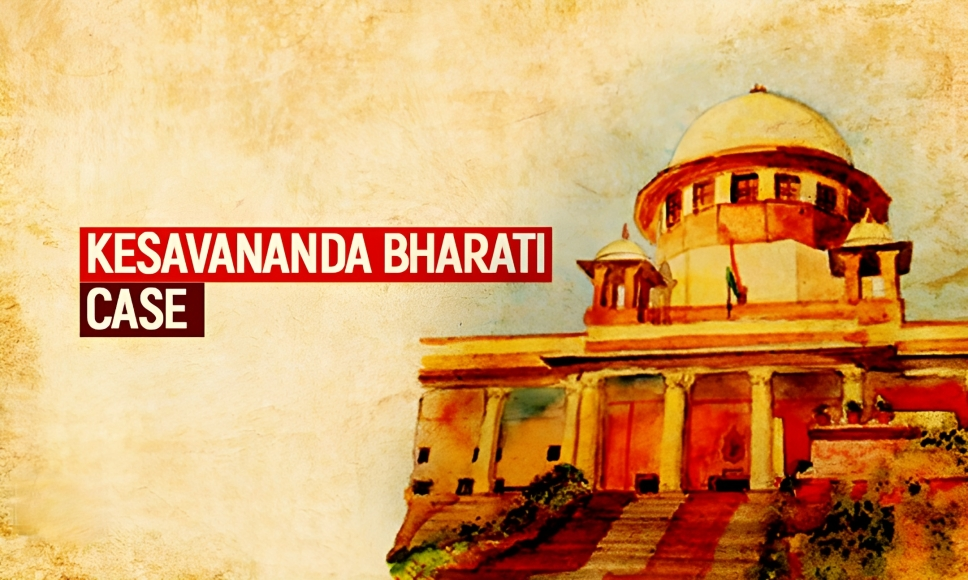Description

Copyright infringement not intended
Context: The landmark decision in the Kesavananda Bharati case marks the 50th anniversary.
Details
- The basic structure concept has been frequently challenged over the years for weakening the principle of separation of powers and eroding Parliament's authority, as well as for providing a vague and subjective form of judicial review.
- The Constitution has been modified more than 60 times since 1973, the year of the Kesavananda Bharati decision.
- In at least 16 decisions over the last five decades, the Supreme Court has put amendments to the Constitution to the test against the concept of basic structure.
- In 9 of these 16 cases, the Supreme Court affirmed constitutional amendments that were challenged as violating the basic structure concept.
- 6 of these cases involve reservations, such as quotas for Other Backward Classes (OBC) and Economically Weaker Sections (EWS), as well as reservations in promotions.
-min.jpg)
Amendment that the Supreme Court completely overturned
- The Constitution (99th Amendment) Act of 2014, which created the National Judicial Appointments Commission (NJAC), the body that would have been in charge of appointing and transferring judges in place of the current Collegium system, was the only constitutional amendment that the Supreme Court completely overturned.
- A Constitution Bench invalidated the amendment in 2015 because it endangered "judicial independence," which the court determined to be a fundamental aspect of the Constitution.
Amendment that the Supreme Court Partially struck down
Kihoto Hollohan v/s Zachillhu and Others (1992)
- The Constitution (52nd Amendment) Act, which added the 10th Schedule—also known as the "anti-defection law"—to the Constitution, was upheld by the Supreme Court.
- The clause in the amendment that indicated that the Speaker's decisions on disqualification could not be subject to judicial scrutiny was the sole part that was overturned.
Rajendra N. Shah v/s Union of India (2021)
- The Constitution (97th Amendment) Act of 2011 was partially overturned by the Supreme Court Bench, but only on procedural grounds and not constitutional ones.
- The court determined that cooperative societies within a state, as opposed to interstate cooperative societies, would fall under the State List, which means that a constitutional amendment relating to it must be ratified by half the states as required by the Constitution. This changed the legal framework for cooperative societies.
State of Kerala v/s Kesavananda Bharati Sripadagalvaru and Ors (1973)
- A clause in the 25th Amendment (1972) stated that "if any law is passed to give effect to the Directive Principles" it cannot "be deemed to be void on the ground that it takes away or abridges any of the rights contained in Article 14, 19 or 31" was struck down by the court.
- The court upheld the laws that were being challenged regarding land ceilings.
Raj Narain v/s Indira Gandhi (1975)
- In this case, the Supreme Court used the Kesavananda concept for the first time.
- It overturned the Constitution (39th Amendment) Act of 1975, which prohibited the Supreme Court from hearing an appeal about the election of the President, Prime Minister, Vice President, and Speaker of the Lok Sabha.
Union of India v/s Minerva Mills Ltd. (1980)
- The Supreme Court overturned a clause inserted in Article 368 (which grants the power to amend the Constitution and lays out the procedure for doing so), which stated that "there shall be no limitation whatever on Parliament's constituent power to amend by way of addition, variation, or repeal the provisions of this Constitution."
P Sambamurthy v/s State of Andhra Pradesh (1986)
- The SC invalidated a section of the 32nd Amendment (1973), eliminating the High Court's authority and creating an Administrative Tribunal for service-related issues in Andhra Pradesh.
Union of India v/s L Chandra Kumar (1997)
- A part of the 42nd Amendment that established administrative tribunals without judicial review by High Courts was invalidated by the Supreme Court.

Kesavananda Bharati case (1973)
About
- It was a landmark judgement of the Supreme Court of India that established the doctrine of the basic structure of the Constitution.
- The case was filed by Kesavananda Bharati, a seer of a religious mutt in Kerala, who challenged the constitutionality of some land reform laws enacted by the state government.
- He argued that these laws violated his fundamental right to property and to manage his religious affairs.
- The case was heard by a 13-judge bench, the largest ever in the history of the Supreme Court. The main issue before the court was whether Parliament had unlimited power to amend any part of the Constitution, including the fundamental rights.
Verdict
- The court delivered a split verdict of 7:6, with the majority holding that Parliament had wide powers to amend the Constitution, but it could not alter or destroy its basic structure or framework.
- The basic structure doctrine was a novel concept that was not defined clearly by the court, but it implied that certain features of the Constitution, such as democracy, secularism, federalism, judicial independence, etc., were essential and inviolable, and could not be abrogated or diluted by any amendment.
Significance
- It established the limits of parliamentary sovereignty and preserved the core values of the Constitution.
- It also paved the way for subsequent judgments that upheld and expanded the doctrine of basic structure, such as;
- Minerva Mills case (1980), struck down a constitutional amendment that gave primacy to the Directive Principles of State Policy over Fundamental Rights.
- Indira Gandhi vs Raj Narain case (1975), invalidated an amendment that sought to immunize the election of the Prime Minister from judicial scrutiny.
- A check on the authoritarian tendencies of the government and a safeguard for democracy and civil liberties.
- It reflects the dynamic and evolving nature of constitutional interpretation and adjudication in India, as well as the complex interplay between law, politics and society.
Conclusion
- The Kesavananda Bharati case has been hailed as a milestone in the constitutional history of India, as it saved Indian democracy from authoritarianism and preserved the balance of power between Parliament and the judiciary.
- The case also marked a shift in the judicial philosophy of the Supreme Court, from being an interpreter of the Constitution to being its protector and guardian.
- The case has had a lasting impact on the constitutional law and politics of India, as it has been invoked and applied in several subsequent cases and controversies.
Must Read Articles:
Basic Structure: https://www.iasgyan.in/daily-current-affairs/basic-structure
|
PRACTICE QUESTION
Q. What are the essential features of the basic structure of the Indian constitution, and what are the major challenges faced by it in the contemporary scenario? How can these challenges be overcome to preserve and protect the basic structure doctrine?
|

https://indianexpress.com/article/explained/explained-law/kesavananda-case-and-its-legacy-sc-has-used-doctrine-sparingly-pushed-back-against-attempts-to-shackle-judicial-review-8572292/











